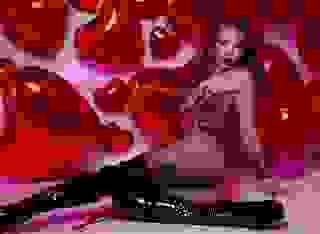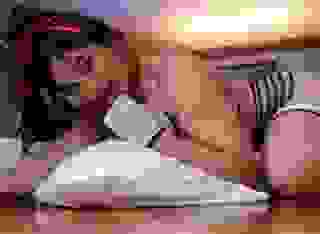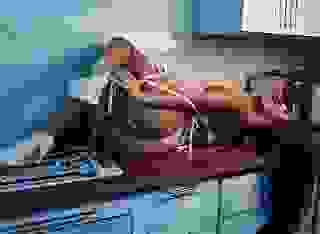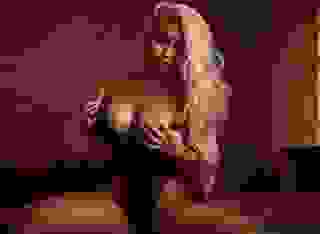Note: You can change font size, font face, and turn on dark mode by clicking the "A" icon tab in the Story Info Box.
You can temporarily switch back to a Classic Literotica® experience during our ongoing public Beta testing. Please consider leaving feedback on issues you experience or suggest improvements.
Click hereNora loved everything about this moment; the way the mecha slammed in and out of her, the way it grabbed her shoulders when a shiver of pleasure shocked it, the vile, nasty things it whispered in Nora's ear when it could manage -- they all shocked and turned Nora on.
"I'm gonna cum," Nora roared, urgently. "Please let me cum on your fucking cock!""
The Gorgosaurus mecha didn't say anything. It didn't need to. Nora could feel it tensing and the mecha's pace quickly became erratic. Forcefully, the robotic entity pinned Nora so her cheek is pressed hard against the table and brutally pound me in her tight, aching, young cunt. Finally the Gorgosaurus mecha announced it's impending climax, but Nora's too lost in her own orgasm to hear it. Her whole body quivered as she came, and her muscles clenched wildly around the Gorgosaurus mecha's metallic dick. Even as the Gorgosaurus mecha filled Nora, it continued to thrust, consumed by the feel of such warmth and heat.
"It's so good, Gorgosaurus..." Nora roared happily, though she had a strawberry tart pressed against her wrist.
Nora raised her ass in the air for the mecha and pushed back on the metallic cock with each slow thrust. The Gorgosaurus mecha just groaned, and humped her already sore bottom. It's arms gripped Nora's shoulders firmly.
During this thrusting, the Gorgosaurus mecha ejaculated. After this, the two Gorgosauruses formed a 'breeding tie'. During this time, the bulbus gland on the Gorgosaurus mecha's penis swelled and the two were locked together. The breeding tie lasted between 2-30 minutes. During this time, they can't be separated as this could cause damage.
An inexperienced slut may start to get anxious at this point and it is important that she is calmed down so she doesn't cause damage to the one who is mounting her. When copulation was finished, the Gorgosaurus mecha's bulbus gland reduced in size and the two separated.
Nora smiled and transformed back into her human form. "That was definitely an unexpected but enjoyable experience," she said. "Can all the SuperMechas do this?"
The Gorgosaurus mecha nodded.
Elsewhere in the museum of natural history....
The other girls were tour guides of the other Dino exhibitions. The Chasmosaurus exhibition was being watched over by Naomi. It also had the same plaques with the following information about the dinosaur.
Weight: Weighed as much as a hippopotamus.
Length: Was over 2 car links long.
Habitat: Lived in what is now North America.
Speed: Could run as fast as a rhinoceros.
Diet: Was an herbivore.
Chasmosaurus was a dinosaur which lived approximately 67 to 70 million years ago during the late Cretaceous Period. It was first discovered in 1898 by Lawrence Morris Lambe around Alberta, Canada. In 1913, Mr. Lambe found another species of this genus, so he decided to name all of his finds Protorosaurus, but found out the name was used for another a reptile species in the 19th century. That is when he decided to name it Chasmosaurus--a name which means "opening lizard"--which he did in 1914. The name refers to the fact that this dinosaur had openings in its frill.
This dinosaur looked very much like a rhinoceros. It had a big frill made of bone emanating from the back of its skull and it had three horns on its face. It had a thick barrel shaped body that was 26 feet long and weighed approximately 3.5 tons. It had short legs that had 5 toed feet and a short tail. Its bony frill and extra horns, as well as its size, distinguishes it from a rhinoceros, but its toothless beak did as well. However, while it didn't have teeth in its beak, it did have cheek teeth which would have been used to grind up all kinds of different plant material.
There are a number of interesting facts about Chasmosaurus that have been discovered by paleontologists. For instance, it is now known that this dinosaur hatched from eggs and may have taken care of those eggs. This is in stark contrast to what paleontologists used to think about dinosaurs. In the past, it was assumed that these massive animals didn't take care of their young. Now that is beginning to look like a false assumption.
This dinosaur might have taken care of its young and may have traveled in large herds. This would make it quite a social dinosaur. This dinosaur was an herbivore, so it ate a lot of different plants--which it would then have easily chewed with its cheek teeth. Some of the plants of the time this dinosaur may have eaten may include seed ferns, cycads and other types of plants.
Paleontologists now believe that Chasmosaurus could protect itself in much the same way a rhino does--by running at full speed and butting the predator with its massive, armored head. This would have been a very effective defense indeed and probably helped this dinosaur fend off some of the nasty carnivores of the time.
Willow was the tour guide of the Ankylosaurus exhibition. It also had the same plaques with the following information about the dinosaur.
Armor: Its armor was similar to that of a modern crocodile.
Weaponry: Its tail was used like a weapon.
Fun Fact: Godzilla's nemesis Anguirus is based on Ankylosaurus.
Habitat: Fossils of this dinosaur have been found in Canada and Montana.
Enemies: Its armor made it almost impossible to be preyed upon.
Ankylosaurus is a dinosaur which lived approximately 70 million years ago during the Cretaceous Period. It was first discovered in 1908 by Barnum Brown. It was named Ankylosaurus--a name which means "fused lizard". Fossils of this dinosaur have been found in Canada and western portions of the United States.
Ankylosaurus is one of the largest armor plated dinosaurs ever discovered. This animal was approximately 30 feet long, 6 feet wide, 4 feet tall and weighed right around 4 tons. It has many large oval plates that were fused into its leathery skin, and these plates covered this dinosaur's entire body except for its belly, which would have been exposed. This dinosaur also had two rows of spikes that traveled down its body, large horns on top of its head and a club like tail that had spikes on it. All of this armor was necessary for it to protect itself from some of the apex predators of the time including the T Rex, Deinonychus and Tarbosaurus. The only way any of these predators could wound the Ankylosaurus would be for them to attack the underbelly of this dinosaur where there wasn't any armor.
These dinosaurs were herbivores--meaning they fed on plants and trees. Since its teeth were insufficient to crush plant matter, it more than likely used their teeth to strip leaves from branches. They would then use fermentation to break down this plant material in their guts.
Although the Ankylosaurus was a well armored creature, it was also quite slow. Computer models suggest that these creatures could only move about 6 miles per hour, which is just slightly faster than a turtle traveling at top speed.
The Parasaurolophus exhibition was being watched over by Rena. It also had the same plaques with the following information about the dinosaur.
Weight: They weighed as much as a full-size van.
Length: They were 4 car lengths long.
Diet: Parasaurolophus was an herbivore.
Physical Distinguishable Trait: It's crest is built like a Crumhorn.
Speed: It's max speed was 25 mph.
Parasaurolophus is a dinosaur that lived about 76 million years ago during the Late Cretaceous Period. It was first discovered in 1922 in Alberta, Canada by Dr. William A. Parks. He named it Parasaurolophus, a name which means "crested lizard". A name he gave the animal because of its prodigious bony crest that exists on top of its head. Fossils of this dinosaur have not only been found in Canada, but has also been found in parts of Utah and New Mexico.
This dinosaur is estimated to have been about 40 feet long, 8 feet tall at the hips and weigh about 2 tons. The bony crest on top of its head is believed to have grown as long as 6 feet long. Some scientists believe that air could be pushed through this crest and that enabled this dinosaur to make low frequency sounds. This means that it could use it like a wood wind instrument. In fact, the canals that exist inside of it look very muchy like a European Crumhorn.
It is also believed that this dinosaur not only traveled on all four legs but could also run on two legs when necessary. Parasaurolophus is believed to have been a land based herbivore. This means that its diet probably consisted of ginkos, pine needles and leaves.
While the exact intelligence of this dinosaur can't be accurately determined, many scientist believe that it has an average intelligence among other dinosaurs for its time. For example, it is believed that it wasn't as smart as Carnosaurs, but that it wasn't as dumb as Stegosaurs. This dinosaur is also believed to have been a herd animal--much like buffalo are.
The Velociraptor exhibition was being watched over by Fiona. It also had the same plaques with the following information about the dinosaur.
Physical Distinguishable Trait: They have hollow bones like a bird.
Name meaning: Their name means "swift robber".
Diet: They were carnivorous scavengers.
Weight: They weighed less than an average turkey.
Habitat: They lived around Central Asia and Mongolia.
Velociraptor is a carnivorous dinosaur which lived during the Cretaceous Period--around 75 million years ago. This species of dinosaur was first discovered by Peter Kaisen in the Gobi Desert on August 11th, 1923. A year later, it was given the name Velociraptor. This name combines the Latin word "Velox", which means swift and the Latin word "Raptor" which means robber.
While this dinosaur has received a lot of attention because it is prominently featured in the Jurassic Park series of movies, scientists believe that the ones in the movie bear little resemblance to those which actually lived in real life. The dinosaurs depicted in these movie were actually based on Deinonychus and not true Velociraptors. In real life, they were only about the size of a turkey and had feathers, and weren't the man-sized reptilian dinosaurs they were depicted in the film. The average Velociraptor weighed approximately 30 pounds and stood a little bit over 3 feet tall.
Another interesting fact about this dinosaur is that it isn't believed to have been as fast as it was portrayed in the Jurassic Park films. In fact, most scientists believe that these dinosaurs could run at a top speed of about 40 miles per hour. Much slower than a cheetah (60 mph) or a lion (50 mph), although it is quite a bit faster than a human at top speed (28 mph).
According to the latest research, it is believed that the Velociraptor hunted and scavenged for small animals. Its diet most likely consisted of reptiles, small mammals, insects and smaller dinosaurs. Although it is usually depicted as being an aggressive hunter in the movies, more than likely it was more of a scavenger than a hunter.
The Pterodactyl exhibition was being watched over by Loriane. It also had the same plaques with the following information about the dinosaur.
Time Period: About 145 to 65.5 million years ago.
Wingspan: More than 36 feet (11 meters) across.
Diet: Meat, fish, and small animals.
Pterodactyl was a pterosaur, a type of flying reptile. It was not a dinosaur, though it lived during the same period. Pterodactyl lived during the Late Jurassic and resided in Africa and Europe.
The first Pterodactyl fossil was discovered in 1815. Probably the most well-known flying dinosaur, the Pterodactyl is not actually a dinosaur at all, but a pterosaur! Pterosaurs were airborne reptiles of the Late Jurassic period, and they are frequently associated with dinosaurs in the popular imagination. It soared through the pre-historic skies of what is now Europe and northern Africa.
In art, the pterodactyl is usually portrayed with bat-like wings, the membranes of which are stretched taut between its elongated fingers. It is also frequently shown with a crest on its head, although there is some debate as to whether this crest was extant in the Pterodactyl as with other Pterosaurs. In fact, many artistic portrayals of the Pterodactyl seem to be heavily influenced by the physiology of the Pteranodon.
The majority of specimens of Pterodactyl have been approximately the size of modern large birds such as hawks and eagles, considerably smaller than the Pteranodon and smaller than many artistic portrayals. Pterodactyls are more correctly known by the scientific term Pterodactylus, and images associated with that term tend to be more accurate and distinct from the Pteranodon.
The Stegosaurus exhibition was being watched over by Star. It also had the same plaques with the following information about the dinosaur.
Brain size: Stegosaurus had the brain of a Walnut.
Tail: Scientists call the Stegosaurus's spiked tail a thagomizer.
Diet: It swallowed rocks to aid in digesting plant matter.
Name meaning: Stegosaurus means "roofed lizard".
Bite force: This dinosaur's bite was weaker than a human's bite.
Stegosaurus is a dinosaur that lived around 155 million years ago--during the Jurassic Period--in the Western portion of North America and parts of Europe. It was an herbivorous quadruped known for its rounded back and its double row of back plates that end with a a double pair of spikes on this dinosaur's tail. This dinosaur was first discovered in 1877 by Othniel Charles Marsh during the Great Dinosaur Rush--also known as the Bone Wars.
Because this dinosaur had armored plates that seemed shingled, it was given the name Stegosaurus, which means "roofed lizard".
An interesting fact to note is that of all of the dinosaurs, Stegosaurus had one of the smallest brains. Although the actual anatomy of this dinosaur's brain is currently unknown, it is known that it only weighed approximately 3 ounces--which is extraordinarily small for a creature that weighed over 5 tons. As such, it is believed that this dinosaur was very simple and slow moving.
The Pachycephalosaurus exhibition was being watched over by Chloe. It also had the same plaques with the following information about the dinosaur.
Skull size: Pachycephalosaurus skull is 30 times thicker than a human's skull.
Weight: It weighed as much as a brown bear.
Length: It was as long as a box truck.
Evolution: Is believed to have evolved from Hypsilophodon.
Motion: It walked on 2 legs.
Pachycephalosaurus is a plant eating dinosaur which lived approximately 75 million years ago during the late Cretaceous Period. It was first discovered in 1938 by William Winkley in Montana. Since then, other fossils of this dinosaur has been found in Canada, Mongolia and Madagascar.
Pachycephalosaurus is believed to have grown to be about 15 feet long and probably weighed in excess of 900 pounds. This dinosaur is known for its five-fingered claws, long powerful legs and three toed clawed feet. However, what it is most known for its it thick domed skull. This dinosaur's skull wall could be as much as ten inches thick. This thick skull plate was also surrounded by bony knobs. Paleontologists believe that this skull plate was used by the dinosaurs either as a self-defense mechanism or to butt heads with other Pachycephalosaurus dinosaurs, kind of like what big horned sheep do. However, some paleontologists believe that this couldn't have been the case. They posit that these dinosaur's skulls were not heavy enough to absorb such impacts and that there haven't been any fossil specimens of this dinosaur that have been found with the skull damage that would likely happen during such impacts.
It is believed that this dinosaur was an herbivore and lived primarily off of plants, fruits and seeds. It is believed that its teeth were incapable of handling some of the tougher foliage like other herbivores of the era, so paleontologist believe that the plants it must have lived off of must have been soft. However, an interesting fact is that it is also possible that this dinosaur lived off of insects as well.
The Plesiosaurus exhibition was being watched over by Kathy. It also had the same plaques with the following information about the dinosaur.
Time Period: Lived from the Early to the Middle Jurassic Period.
Habitat: Lived in oceans all over the world.
Lifestyle: Was a marine reptile.
Breeding Ability: May have laid eggs in the sand like sea turtles.
Length: Was twice as long as a horse.
Weight: Weighed twice as much as a pig.
Living Capability: They breathed air.
Diet: Was a Piscivore and/or Carnivore.
Plesiosaurus is an extinct marine reptile which lived approximately 135 million to 120 million years ago -- from the Early to the Middle Jurassic Period. It was first discovered in the winter of 1823 by fossil hunter Mary Anning in Western Europe. It was named the following year by William Conybeare. The name of this reptile means "almost lizard."
Plesiosaurus is not only the name of this reptile species but is also the name of the family to which it belongs. This family of reptiles is characterized by their long necks, sleek bodies, small heads and wide flippers. As you can tell from Plesiosaurus pictures it makes them look very much like a combination of a snake and a turtle.
One of the most interesting facts about Plesiosaurus is that these reptiles probably weren't very good swimmers. Of course, they did well enough to have been able to swim but they weren't as adapted to it as Pliosaurs were. These reptiles were also smaller than Pliosaurs -- with Plesiosaurus coming in at only about 15 feet long and 1,000 pounds. That means they were twice as long as a modern horse and weighed twice as much as a modern hog.
It is believed that these animals behaved very much like tea turtles live today. Which means they probably had to come to shore to lay their eggs. This would have made the eggs very vulnerable to predators. To help avoid their eggs being eaten by other animals, Plesiosaurus most likely buried them into the soft sand.
What did Plesiosaurus eat? These dinosaurs had very sharp teeth and incredibly strong jaws. This allowed them to not only feed on fish of all sizes but also on any other swimming animals that may have been in the ocean at that time. Their strong jaws and sharp teeth may have also allowed them to have eaten mollusks that lived along the prehistoric shoreline.
The Titanosaurus exhibition was being watched over by Courtney. It also had the same plaques with the following information about the dinosaur.
Name meaning: Their names mean "arm lizards".
Weight: They weighed as much as 4 elephants.
Height: They stood over 2 1/2 stories high.
Length: They were as long as 2 railroad cars.
Habitat: They lived in North America, Africa and Tanzania.
The Titanosaurus is a dinosaur which lived about 156 million years ago during the Jurassic Period. They were massive animals that stood about 23 feet high, were 85 feet long and weighed between 30 through 80 tons. The first remains of this dinosaur were discovered in 1903 by Elmer S. Riggs in Western Colorado.
Titanosaurus is known for its long neck--which made it look very much like a giraffe--and its short hind legs. The front legs of this dinosaur is so much larger than the hind legs, it caused Mr. Riggs to name it Titanosaurus--a name which means "arm lizard".
It is believed that these massive animals were warm blooded and not cold blooded like most reptiles. Scientists have been able to determine this by examining the teeth of these animals and calculating body temperature of the dinosaur by measuring the ratios of certain isotopes.
These dinosaurs are known to have been herbivores. It is believed that they subsisted mainly on conifers, ginkgos and cycads.
The teens then headed to their HQ.








